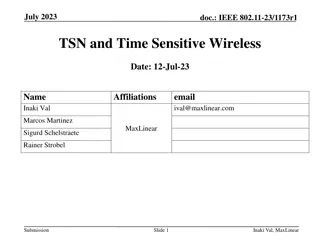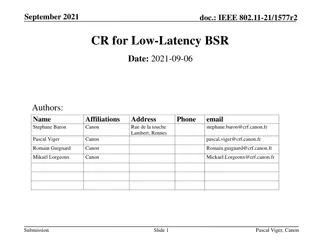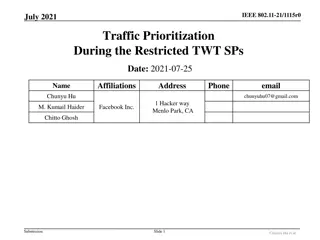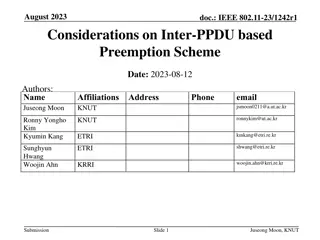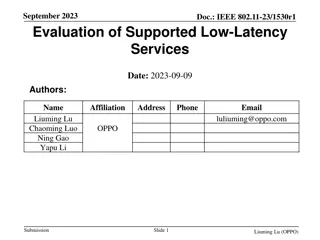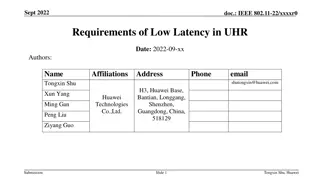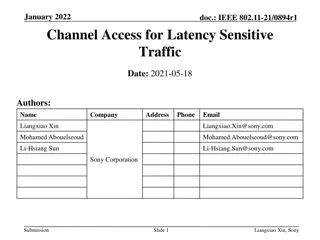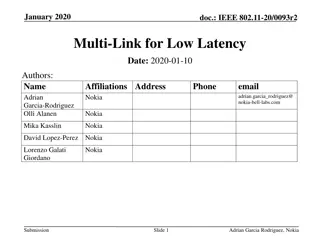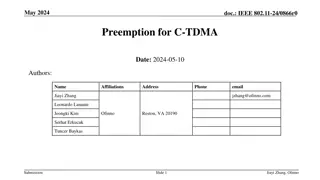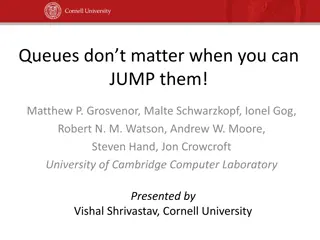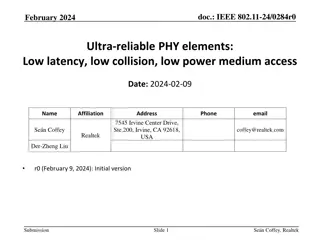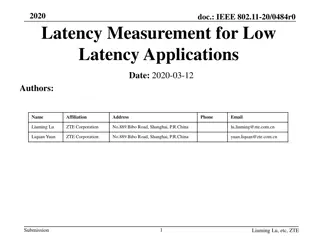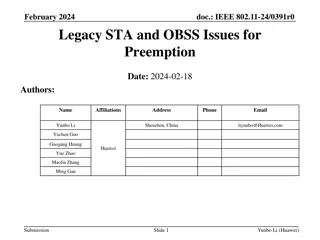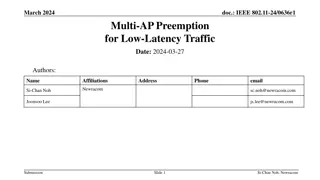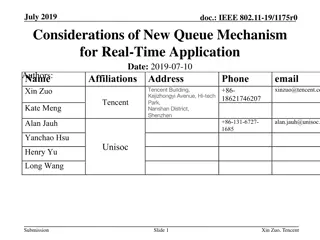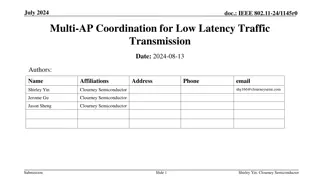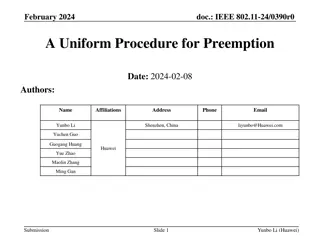IEEE 802.11-24/0852r1: Timely Transmission of Low Latency Traffic with Reduced Preemption Occurrence
This document discusses the challenges of ensuring timely transmission of low-latency traffic while minimizing preemption occurrences in IEEE 802.11 networks. It addresses issues related to operating modes, preemption mechanisms, and the impact on user experience. The submission proposes solutions to improve efficiency and reduce disruptions caused by preemption events, aiming to enhance overall network performance and quality of service.
Uploaded on Oct 10, 2024 | 2 Views
Download Presentation

Please find below an Image/Link to download the presentation.
The content on the website is provided AS IS for your information and personal use only. It may not be sold, licensed, or shared on other websites without obtaining consent from the author.If you encounter any issues during the download, it is possible that the publisher has removed the file from their server.
You are allowed to download the files provided on this website for personal or commercial use, subject to the condition that they are used lawfully. All files are the property of their respective owners.
The content on the website is provided AS IS for your information and personal use only. It may not be sold, licensed, or shared on other websites without obtaining consent from the author.
E N D
Presentation Transcript
July 2024 doc.: IEEE 802.11-24/0852r1 Timely Transmission of Low Latency Traffic with Reduced Preemption Occurance Date: 2024-07-17 Authors: Name Affiliations Address Phone email shy166@clourneysemi.com Shirley Yin Clourney Semiconductor Jerome Gu Clourney Semiconductor Jason Sheng Clourney Semiconductor Submission Slide 1 Shirley Yin, Clourney Semiconductor
July 2024 doc.: IEEE 802.11-24/0852r1 Introduction Enabling at least one mode of operation capable of improving the tail of the latency distribution and jitter compared to EHT MAC/PHY operation, with mobility between BSSs is one of the objectives of 802.11bn[1]. In [2-6], the details of preemption mechanism are provided, nevertheless, how to guarantee both the timely transmission of low latency traffic and user experience related to preemption is always an important problem. Regarding this, a scheme to release Nss for low latency traffic in EMLMR operation is given in [7], however, it is limited to EMLMR only. In this submission, we discuss the problem with a general solution, w.r.t the operating mode[8] and emerging capability mode [9]. Submission Slide 2 Shirley Yin, Clourney Semiconductor
July 2024 doc.: IEEE 802.11-24/0852r1 Recap Operating mode is supported in 11be[8] The operating mode is related to BW, Nss, and etc.. The initiating STA may request to change the Operating Mode of the responding STA For example the initiating STA has or will have certain changes (e.g., operating mode, network conditions or throughput/latency/QoS requirements) and requests the responding STA to change its operating mode (e.g., for better throughput, latency, QoS, etc.) The responding STA may be running in certain operating mode and may accept or deny the Operating Mode Request. A Motion on capability mode was approved[9] TGbn defines a power save mode for a STA that is a UHR Mobile AP or a UHR non-AP STA wherein the STA may transition from a lower capability mode to a higher capability mode upon reception of an initial control frame Lower capability mode (e.g., 20 MHz BW, one SS, limited data rates, PPDU format) Higher capability mode (e.g., operating BW, Nss and MCSs, with at least one higher capability than that in the lower power capability mode) Submission Slide 3 Shirley Yin, Clourney Semiconductor
July 2024 doc.: IEEE 802.11-24/0852r1 Problem statement In the existing preemption mechanisms, the ongoing transmission in the current TXOP is terminated, in order to complete the transmission of low latency traffic in the remaining TXOP. Deliver the LL traffic by preemption is rude and rough: Problem 1: When LL traffic arrives, it may not be well supported by the current capability mode or operating mode of the preempting STA (STA2). If the preempting STA(STA2) is continuously maintain a current lower capability mode mode, the LL traffic can not be timely transmitted even with preemption. AP s TXOP LL transmission could not be transmitted before the end of the TXOP DL PPDU2 BA DL PPDU1 TF AP Transmitting STA (STA1) PRI LL data Preempting STA (STA2) Remaining TXOP Problem 2: Besides, the impact from preemption on the transmitting STA(STA1) is tremendous. It means transmission termination, may lead to bad QoS, or QoE for STA1. Submission Slide 4 Shirley Yin, Clourney Semiconductor
July 2024 doc.: IEEE 802.11-24/0852r1 Problem 1: Timely transmission of LL traffic Sometime, the preempting STA(STA2) is in a lower capability mode, or low operating mode, which does not well support the in-time delivery of LL traffic. In this case, it is desirable that the preempting STA(STA2) is able to change the capability mode or operating mode, adapt them to the LL traffic, so as to make sure the timely transmission of LL traffic. AP s TXOP By adjusting the capability mode or operating mode of STA2, the LL transmission can be delivered before the end of TXOP. the interrupted transmission could be completed within the TXOP, too. DL PPDU2 BA DL PPDU1 TF AP BA Transmitting STA (STA1) Preempting STA (STA2) PRI LL data Remaining TXOP Submission Slide 5 Shirley Yin, Clourney Semiconductor
July 2024 doc.: IEEE 802.11-24/0852r1 Problem 2: Reduce impacts from preemption The transmitting STA(STA1) contributes part of its resources to the LL traffic, instead of preemption. The transmitting STA(STA1) may be working on a certain capacity mode or a certain operating mode that occupies a lot of resources. In this case, the transmitting STA(STA1) can contribute a portion of its resources to LL traffic(of STA2), and retain the remaining resources to avoid transmission termination. For STA1, this process means turning into another capability mode or certain operating mode, to spare a portion of its resources for the LL traffic(of STA2). Previously, preemption Change capability/operating mode The transmitting STA(STA1) A portion of resources is contributed. Ongoing transmission NOT terminated. Good QoE. The transmitting STA(STA1) TXOP is preempted. Ongoing transmission terminated. Bad QoE. LL traffic transmission Slide 6 Submission Shirley Yin, Clourney Semiconductor
May 2024 doc.: IEEE 802.11-24/0852r1 Discussions Without dynamically changing the capability mode or operating mode, it is highly likely that the LL traffic can not be transmitted in time and the ongoing transmission is severely impacted, especially when the data amount of LL traffic is huge, e.g., the VR/XR case. the due time is tight for the LL traffic. the preempting STA with a certain unfriendly capability mode or operating mode for the LL traffic. The capability mode or operating mode of the preempting STA should be adjusted. To well support the LL traffic transmission When LL traffic is indicated, the transmitting STA can change to a lower capability mode or operating mode. This spares additional free resources for the timely and smoothly transmission of the LL traffic. Submission Slide 7 Shirley Yin, Clourney Semiconductor
July 2024 doc.: IEEE 802.11-24/0852r1 Summary Regarding either a transmitting STA or a preempting STA, changing the capability mode or operating mode is needed. It benefits the timely delivery of LL traffic. It mitigates the impact from preemption and brings good QoE for the transmitting STA. Submission Slide 8 Shirley Yin, Clourney Semiconductor
July 2024 doc.: IEEE 802.11-24/0852r1 References [1] 23/0480r3, UHR Proposed PAR [2] 24/0390r0, A Uniform Procedure for Preemption [3] 24/0389r0, Preemption for Low Latency [4] 24/0168r0, TXOP preemption in 11bn [5] 24/0391r0, Legacy STA and OBSS Issues for Preemption [6] 24/0103r1, TXOP Level Pre-emption for Low Latency Application [7] 23/1593r0, Low Latency Transmission in EMLMR [8] 24/0797r0, Operating Mode Request [9] 24/0176r6, TGbn Motions List Submission Slide 9 Shirley Yin, Clourney Semiconductor



